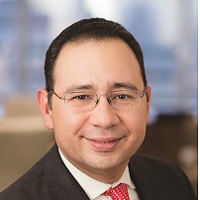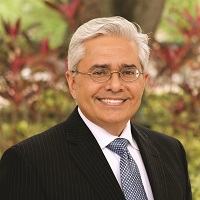By EB5 Investors Magazine Staff
EB5 Investors Magazine is pleased to announce the Top 15 Corporate and Securities Attorneys. To be eligible, distinguished attorneys needed to primarily draft offering documents for EB-5 financing.
For more information or to contact any of these professionals, we invite you to view their listings at www.EB5Investors.com/directories.
ROGELIO CARRASQUILLO
CARRASQUILLO LAW GROUP P.C. | MANAGING SHAREHOLDER

Rogelio “Roy” Carrasquillo is the managing shareholder of Carrasquillo Law Group P.C. and chair of its EB-5 Immigrant Investor Program services and compliance practice. He is experienced with public-private partnership projects using EB-5 funds and other economic incentives, including Opportunity Zones and tax credits (LIHTC, NMTC, HTC). He assists clients in equity and debt offerings registered under U.S. securities laws as well as the issuance of equity and debt in transactions, principally Regulation S and Regulation D offerings. Carrasquillo is a graduate of Georgetown University and University of Pennsylvania and is admitted to practice in New York and Puerto Rico.
WHAT TRENDS ARE YOU SEEING IN THE EB-5 INDUSTRY?
Due to the difficulties to raise capital for larger transactions, we are seeing clients focus on successful smaller raises and EB-5 direct deals. These deals also tend to integrate various sources of funds to the project’s capital stack, including tax credits, grants and bonds. We have also seen a shift in marketing of projects. Clients are no longer focusing on China, but instead focusing in alternative markets such as Latin America and India. Finally, we are seeing that developers and regional centers are also focusing their attention on securities law compliance at all stages of the EB-5 transaction.
HOW ARE YOU HANDLING THE ISSUE OF REDEPLOYMENT?
We work with our clients to ensure that their EB-5 offering documents cover redeployment both from a securities and immigration point of view. We include options to provide our clients flexibility and compliance with USCIS rules and regulations. We try to reach a balance between protecting the investors, providing the right disclosures, and providing the developer the highest level of flexibility in the process of redeployment. Nonetheless, when dealing with older transactions that did not originally contemplate redeployment, we are very careful to evaluate our clients’ options to ensure compliance with immigration and securities rules and regulations.
RONALD FIELDSTONE
SAUL EWING ARNSTEIN & LEHR LLP | CHAIR OF GLOBAL IMMIGRATION & FOREIGN INVESTMENT

Ronald Fieldstone, chair of Saul Ewing Arnstein & Lehr LLP’s global immigration and foreign investment group and head of the Firm’s Opportunity Zone group , practices primarily in the areas of corporate/securities and taxation law. Fieldstone serves as corporate/securities counsel for industries involving EB-5 investor offerings. He represents developers and regional centers in EB-5 matters, currently handling more than 300 EB-5 projects with combined capital raise of nearly $8 billion. His corporate/securities work includes the preparation of private placement memoranda and related documents. Fieldstone lectures and publishes about the subject of EB-5 corporate/ securities for numerous government -sponsored organizations, industry groups and associations.
WHAT TRENDS ARE YOU SEEING IN THE EB-5 INDUSTRY?
The EB-5 industry is going through a major transition due to uncertainty in legislation, retrogression and a shift in marketing outlets. We will experience transactions becoming more economically attractive to the EB-5 investors, with a more meaningful rate of return combined with far more equity from developers and greater transparency in the offering elements and marketing materials. Marginal projects will not survive in the new market conditions.
HOW ARE YOU HANDLING THE ISSUE OF REDEPLOYMENT?
Since 2009, the industry progressed. I became involved in all facets of the process, including the securities law issues making numerous regulatory requirements that had a significant impact on the structuring of transactions. I needed to become a quasi-expert in the immigration components of the program to better understand the securities and corporate issues. I used this background to also undertake work related to SEC investigations, tax planning matters and the real estate component of the loan models. I have enjoyed the multidisciplinary aspects of the program.
CATHERINE D. HOLMES
JMBM | PARTNER & CHAIR OF INVESTMENT CAPITAL LAW GROUP

Catherine D. Holmes is chair of JMBM’s investment capital law group, and the author of the Investment Law Blog. She has practiced law at JMBM for over 30 years, focusing on investment capital and business transactions. Holmes helps clients worldwide to raise, invest and manage capital from U.S. and non-U.S. investors. She has represented more than 100 real estate developers in obtaining financing through the EB-5 immigrant investor visa program for the development of hotels, multi-family and mixed-use developments through the U.S., and has represented numerous Chinese investors in the purchase of hotels and businesses in the U.S.
WHAT TRENDS ARE YOU SEEING IN THE EB-5 INDUSTRY?
There is and will continue to be a substantial reduction in EB-5 investors from China due to the 15-year waiting period to obtain a U.S. conditional residency visa. This has caused a significant reduction in new EB-5 projects, because EB-5 investors from other parts of the world have not made up in numbers for the reduction in investors from China. There is also an increase in uncertainties on the part of both NCEs and EB-5 investors arising from the USCIS requirement for redeployment of funds. These issues need to be addressed through legislation and/or changes in USCIS regulations and policy.
HOW ARE YOU HANDLING THE ISSUE OF REDEPLOYMENT?
In the absence of clarification from USCIS, NCEs are required to make judgements as to what types of redeployment will meet USCIS policy, while at the same time attempting to address the concerns of EB-5 investors that their capital is being used for new investments that they never contemplated when they made their original investment decision. The safest form of redeployment from both of these perspectives may be a redeployment in a project that is substantially similar to the original EB-5 investment, although a pooled fund may provide greater diversification and liquidity and better address the needs of the investors.
MICHAEL HOMEIER
LAW OFFICE OF MICHAEL G. HOMEIER, PC | PRINCIPAL

Michael Homeier practices securities, corporate and transactional law (including EB- 5, crowdfunding, and blockchain), bringing over 30 years of experience. He represents EB-5 issuers, regional centers and developers on project structuring and drafting EB-5 securities and business documents, including PPMs and offering, transactional, and corporate documents. With his prior firm Homeier Law PC, Homeier is a leader in EB-5- related securities transactions, engaging with more than 400 EB-5 projects since 2009. He speaks frequently on EB-5, crowdfunding and blockchain, also as an inspirational speaker to young adult cancer survivors (as one himself) on post-treatment life success.
WHAT TRENDS ARE YOU SEEING IN THE EB-5 INDUSTRY?
Despite reports of its imminent demise, today’s EB-5 industry continues moving forward, slogging through lengthening investment horizons, continued processing delays and highly competitive investor marketplaces. Following closure of the China market, new and renewed markets in India, Vietnam, Korea and even South Africa are being tapped. Overt securities fraud cases diminish, as quality projects, in particular small, direct projects, find investors. Global immigrants continue preferring the USA, so if enhanced integrity, reasonably increased investment minimums and heightened RC oversight can be balanced by increased visa numbers and reduced processing times, continued EB-5 growth could continue. It’s well worth the effort.
HOW ARE YOU HANDLING THE ISSUE OF REDEPLOYMENT?
As a securities lawyer, disclosure is key. SEC requires informing investors about the redeployment strategy; it does not require any particular strategy. Prospective investors must be informed in the PPM, before they make the investment decision, what is the EB-5 issuer’s redeployment strategy in significant detail (what alternate investment(s), timeline, and risks, will management select, may investors decide to opt in or out, are alternates in line with the issuer’s initial purpose, etc.). All are disclosed to the maximum extent reasonably practicable. With this roadmap, the issuer must then follow it if a repayment happens. It’s delicate, but doable.
ANDREW KINGSTON
KINGSTON PETERSEN, PLLC | PRINCIPAL

Andrew Kingston is a principal with Kingston Petersen, PLLC. Andrew has acted as EB-5 securities and corporate counsel since 2009. He served as general counsel to private and publicly traded companies, and was a founding partner of NNDKP, one of the largest law firms in southeastern Europe. He taught corporate finance in emerging markets at Cornell Law School and was law clerk to Harold M. Fong, Jr., chief judge of the U.S. District Court in Hawaii. He received his B.A. from University of Virginia and his J.D. from Harvard Law School. He is a member of the Washington State Bar.
WHAT TRENDS ARE YOU SEEING IN THE EB-5 INDUSTRY?
This was the year the plaintiffs’ bar finally discovered EB-5. Investor lawsuits have put further pressure on sponsors that played fast and loose with their fiduciary duties and the federal securities laws. However, plaintiffs’ lawyers are often unable to distinguish legitimate projects that were economically unsuccessful from fraudulent projects that broke the law. They will get better at this. Meanwhile, sponsors of legitimate projects are learning that a robust investor communications program, both during and after construction, can reduce investor misunderstanding, anger and frustration — the breeding ground of lawsuits.
HOW ARE YOU HANDLING THE ISSUE OF REDEPLOYMENT?
We generally handle redeployment as a matter to be decided by super-majority investor consent, not by the NCE managers. This reduces opportunities for self-dealing and gives investors a say in what happens to their money. It also protects the NCE managers, most of whom are not registered investment advisers and therefore not licensed to make redeployment decisions with other people’s money. Some NCE operating agreements now allow individual investors to decide how to redeploy their capital contributions, though this is not yet a widespread practice.
JOR LAW
LEXCUITY PC | ATTORNEY

Jor Law is a corporate and securities attorney with Lexcuity PC. Prior, he also founded the EB-5 practice for Homeier Law PC, which has represented clients on hundreds of EB-5 projects that have raised billions of dollars. Law is always on the cutting edge of alternative finance and trends that impact EB-5. He worked on regional center deals and the loan model before they were popular, and he focused on smaller, non-regional center deals before they picked up interest again in recent years. He was among the first to look at integrating Opportunity Zone funds, crowdfunding and the blockchain with EB-5 transactions.
WHAT TRENDS ARE YOU SEEING IN THE EB-5 INDUSTRY?
EB-5 has been forced to diversify into more countries as retrogression impacts the appetite of investors from certain countries. Successful issuers are not just diversifying where they market, but also how they market. They are implementing crowdfunding techniques, investing the benefits of tokenization, and looking at alternative sources of capital such as Opportunity Zone funds to supplement their EB-5 capital raises.
HOW ARE YOU HANDLING THE ISSUE OF REDEPLOYMENT?
Redeployment is contemplated both at the time of the initial offering as well as at the time redeployment becomes necessary. It’s important to draft flexibility yet certainty into the original documents to give EB-5 issuers clear rights to redeploy while comforting investors as to how their capital might be redeployed. The language should cover existing EB-5 regulations but have the flexibility to accommodate anticipated changes to EB-5 regulations. Engaging appropriate third parties to assist with the redeployment might be advisable for those who wish to minimize liability.
RIKARD LUNDBERG
BROWNSTEIN HYATT FARBER SCHRECK, LLP | SHAREHOLDER

Rikard Lundberg represents private and public companies from various industries such as recreation, hospitality, media, alternative energy, gaming and consumer products in a broad range of matters and transactions, including public and private securities offerings (equity and debt), EB-5 transactions, mergers and acquisitions, corporate contracting and general commercial and corporate matters. Lundberg has represented regional centers, developers and service providers in EB-5 transactions and has a wealth of experience counseling clients on the corporate and securities law aspects of EB-5 transactions and leading successful teams in drafting and negotiating the complex and voluminous documents that drive an EB-5 transaction.
WHAT TRENDS ARE YOU SEEING IN THE EB-5 INDUSTRY?
The continued uncertainty about EB-5 program reform is having a chilling effect on businesses and markets. Expected integrity measures, together with the SEC’s continued enforcement efforts and private litigation, have led industry participants to focus on compliance matters. Furthermore, there is increasing focus on use of third-party service providers in project due diligence and oversight. Market-wise, increasing visa wait times for Chinese-born investors has lowered demand, forcing EB-5 projects to seek capital in less developed emerging markets, resulting in increased competition for fewer investors, longer capital raising time and smaller project sizes.
HOW ARE YOU HANDLING THE ISSUE OF REDEPLOYMENT?
In new transactions, I craft the relevant organizational documents and investor disclosures to provide authority for the investment entity to redeploy funds and hire an investment adviser, if necessary. I also consider interplay with other investment terms, such as investor distributions and return of capital. In existing transactions, I review relevant documents and disclosures made at the time of the original investment to determine whether the investment entity has authority to redeploy and on what terms. If there is no such authority, it may be necessary to obtain investor consent before redeploying.
JENNIFER MOSELEY
BURR & FORMAN LLP | PARTNER

Jennifer Moseley is a corporate and securities partner at Bur r & Forman LLP in Atlanta, and advises small startups to large public companies in an array of transactions and capital-raising activities. She enjoys resolving her clients’ needs in her role as counselor to startup and developmental stage companies. Moseley was introduced to EB-5 in early 2008 and addressed securities law implications in EB-5 during the early years, when securities law was not at the forefront of EB-5-related discussions. She continues to help clients navigate the intricacies of securities laws with practical solutions to meet their goals.
WHAT TRENDS ARE YOU SEEING IN THE EB-5 INDUSTRY?
With backlogs on visa processing and proposed legislative changes, I continue to see direct EB-5 investments becoming more popular, particularly with investments moving toward a wider variety of projects outside of big real estate developments. In addition, due to increasing negative views of EB-5, I think there will be more inter-agency cooperation and emphasis on oversight, particularly from the SEC, in the reforms. Finally, as EB-5 investors become savvier of the intricacies of EB-5 requirements, investors’ and regional centers’ attention will turn toward more complex issues such as individual tax consequences, and service providers in this area will increase.
HOW ARE YOU HANDLING THE ISSUE OF REDEPLOYMENT?
I have discussions upfront with the JCE about other projects into which we could redirect EB-5 funds in case an investment will be repaid before an EB-5 investor has had his or her I-829 petition adjudicated, and more migration agents are requesting this upfront. Funds can be redeployed to a project of a different developer, but typically I negotiate with the JCE to provide contractual obligations allowing the regional center to redirect funds to a future project of the same JCE. When the JCE has a proven track record, investors have a higher level of comfort in redeployment.
SCOT PATRICK O’BRIEN
AKERMAN LLP | MANAGING PARTNER

Scot Patrick O’Brien serves as the Washington, D.C. , office managing partner for Akerman LLP, a national law firm with over 700 attorneys. O’Brien helps his clients in the corporate life cycle to raise capital, structure corporate ventures, resolve conflicts, acquire/develop assets and real estate, manage operations and ultimately sell, refinance or reposition the business enterprise or real estate development. For those involved in the EB-5 Immigrant Investor Program, O’Brien also represents developers, investment companies and regional centers in the creation of, and/or investments in, regional centers and new commercial enterprises throughout the United States.
WHAT TRENDS ARE YOU SEEING IN THE EB-5 INDUSTRY?
The SEC is increasing its understanding of the EB-5 process and recently has begun to question the applicable federal exemptions for securities offerings, which is important for issuers to be aware of. As more capital is being raised in other jurisdictions beyond China, the need for the issuer to understand how foreign advisors, agents and finders are regulated in such jurisdictions becomes important, as does the need for robust foreign advisor/ agent agreements.
HOW ARE YOU HANDLING THE ISSUE OF REDEPLOYMENT?
We have taken a conservative approach to redeployment. While we have built in a fair amount of flexibility for issuers, we ultimately believe and generally advise that unless the new redeployment project has been appropriately disclosed in the initial offering documents, that the issuers obtain the consent of EB-5 investors (as determined in the governing operating or partnership agreement) before the investors’ funds are reinvested in an unrelated project. We renew our request for USCIS to issue further guidance on what redeployment options would be sufficient to maintain the at-risk status during the period of conditional residency.
ERIC S. ORENSTEIN
ROSENBERG & ESTIS, P.C. | MEMBER

Eric S. Orenstein is a member at Rosenberg & Estis, P.C. Orenstein has developed a thriving lending practice and is at the forefront of the EB-5 market. Additionally, he currently represents lenders, owners and developers nationally, providing his legal expertise in all aspects of real estate, such as financing, development, and purchase and sale transactions. Because of his close interaction with clients, he has been able to develop an understanding of all the issues concerning his clients from both a legal and business prospective. His experience provides him with the ability to protect his clients’ interests while achieving their goals.
WHAT TRENDS ARE YOU SEEING IN THE EB-5 INDUSTRY?
There is significant uncertainty for EB-5, with the regional center program expiring Dec. 7. We are hopeful that with new leadership in the House, a deal acceptable to all parties can be reached so that the EB-5 program can be extended on a longer term basis. Such a longer extension would provide much-needed stability to the program. While mainland China continues to be the largest user of EB-5, Vietnam and India users have grown significantly in recent years and this momentum may continue.
HOW ARE YOU HANDLING THE ISSUE OF REDEPLOYMENT?
We have been advising our clients that they need to follow several key factors when it comes to redeployment. The most important aspect of redeployment is early, clear and consistent communication with investors about the repayment of the initial deployment of capital and the plans for redeployment of such capital. Second, timing is critical. As we all know, the capital must remain “at-risk.” We have urged our clients to get out into the marketplace now to start identifying opportunities for redeployment and educating real estate professionals (owners, developers and mortgage brokers) of the impending influx of redeployment capital.
JACKIE PRESTER
BAKER DONELSON BEARMAN CALDWELL & BERKOWITZ. P.C. | SHAREHOLDER

Jackie Prester is a shareholder in the Memphis office of Baker Donelson Bearman Caldwell & Berkowitz. P.C., with 22 years of experience in the corporate and securities practice areas. Prester is the practice group chair of the firm’s financial services transactions practice group. She has particular experience advising clients on securities issues relating to the EB-5 Immigrant Investor Program. This experience includes helping clients draft private placement memorandums, negotiating agreements with broker-dealers and other securities professionals, and advising on securities compliance issues.
WHAT TRENDS ARE YOU SEEING IN THE EB-5 INDUSTRY?
We’ve noticed more investor solicitation activities from within the United States. These activities raise securities compliance issues different from overseas offerings, such as ensuring that the requirements for the Regulation D private offering exemption are met. Domestic solicitation efforts also raise more compliance issues relating to broker-dealer registration. The SEC has initiated a number of enforcement actions within the past few years penalizing persons who engage in EB-5 investment solicitation activities for failing to register as broker-dealers. The SEC has also penalized the issuers and their sponsors who compensate such unregistered persons.
HOW ARE YOU HANDLING THE ISSUE OF REDEPLOYMENT?
We draft the securities disclosure documents to clearly advise potential investors of the potential for redeployment and the immigration and financial risks associated with redeployment of funds. Our governance documents provide that the manager or general partner has the authority to redeploy funds, and we work with issuer clients to craft the desired and appropriate balance of flexibility and commitment to attract investors.
JAY M. ROSEN
SAUL EWING ARNSTEIN & LEHR LLP | PARTNER

Jay M. Rosen, a partner with Saul Ewing Arnstein & Lehr LLP, focuses his practice in general corporate and securities law. He has represented both public and private companies in connection with mergers and acquisitions, public and private offerings of securities and SEC disclosures, as well as corporate governance, debt and equity financing, and general corporate matters. Rosen’s practice also includes handling private offerings under the EB-5 immigrant investor visa program. He serves as lead attorney on numerous projects from inception to closing, including contract negotiation and preparation.
WHAT TRENDS ARE YOU SEEING IN THE EB-5 INDUSTRY?
Mainly as a result of visa retrogression in China, there has been a substantial slow-down in new EB-5 projects in the market in general. In particular, larger-sized EB-5 financings, which have generally been dependent on the large pool of EB-5 investors from China. That being said, we continue to see new EB-5 project activity with respect to smaller-sized EB-5 capital raises in other markets, such as in India and throughout Latin America. Furthermore, we are structuring and negotiating more and more redeployment transactions for existing clients, as their previously-funded EB-5 capital is being paid back and needs to remain “at-risk.”
HOW ARE YOU HANDLING THE ISSUE OF REDEPLOYMENT?
We analyze, review and negotiate many issues in order to properly structure and implement redeployment transactions from all angles, including from immigration, corporate/ fiduciary and securities compliance standpoints. We work closely with project immigration counsel to ensure a redeployment transaction complies with current USCIS guidelines/policy (which is always evolving), and we review applicable offering and corporate documents to ensure NCE management may proceed with the proposed redeployment, otherwise needs investor consent or must take other steps. Redeployment has many complexities, and we are very strategic in structuring and implementing the most appropriate redeployment based on each client’s particular circumstances.
JOHN TISHLER
SHEPPARD MULLIN | PARTNER

John Tishler practices corporate and securities law as a partner at Sheppard Mullin, a global law firm. He is leader of the EB-5 project finance practice and has served from time to time as leader of the public companies and capital markets group. Tishler’s practice includes domestic and international capital markets, corporate finance, corporate governance, business transactions, mergers and acquisitions and technology. For more than 25 years, Tishler has helped clients in designing and executing successful investment programs. He represents developers, regional centers and other intermediaries for their participation in the EB-5 program. Tishler is a leading EB-5 securities and project finance attorney.
WHAT TRENDS ARE YOU SEEING IN THE EB-5 INDUSTRY?
Deals must now be designed to sell in markets other than China. Different markets have different investor expectations and different marketing needs. Common to all of them is that investors and migration agents are increasingly sophisticated about project selection and credit quality. For example, most investors no longer accept the risk associated with a project that depends on EB-5 funds for completion. We are therefore seeing almost all deals structured as repayment of bridge capital as USCIS guidance permits. For deals that were completed in the past, we are seeing an increasing number of disputes associated with EB-5 financing.
HOW ARE YOU HANDLING THE ISSUE OF REDEPLOYMENT?
Our firm has always included redeployment planning for EB-5 clients. We believe the USCIS requirement to keep investments at-risk through the investors’ sustainment periods increases EB-5 capital’s value to the users of that capital and helps offset the high upfront costs of the capital. Without available redeployment into other projects, many developers would pass on EB-5. Of course, redeployment presents risks – which is exactly the point, as USCIS requires redeployed funds be at-risk. Migration agents are negotiating redeployment as part of project underwriting. Redeployment requires balancing the interests of investors, intermediaries and developers in the face of regulatory uncertainty.
OSVALDO F. TORRES
TORRES LAW, P.A. | SHAREHOLDER

Osvaldo F. Torres graduated from the University of Pennsylvania Law School in 1987. During his 30-year career, Torres has prepared offering documents for a variety of projects. For the past eight years, Torres has been immersed in the EB-5 space. He regularly represents regional centers, developers and projects with their structuring and offering matters, including hotel, multi-family, senior living, franchising and other projects. Torres frequently speaks at EB-5 conferences on securities issues. He is a member of the EB-5 SEC Roundtable, serves on IIUSA’s leadership, public policy and editorial committees, and is rated AV Preeminent by Martindale-Hubbell.
WHAT TRENDS ARE YOU SEEING IN THE EB-5 INDUSTRY?
Considering the visa backlog impacting mainland Chinese investors, we have seen more of our clients having to deal with investor withdrawals. As investor patience wanes due to the backlog, issuers are facing increasing pressure from investors to release them from the projects and return investor funds. In most cases, the relevant agreements simply do not provide for a voluntary investor withdrawal. We nonetheless spend significant time preparing and negotiating withdrawal agreements on behalf of our corporate clients. We have also seen more individual investors engaging with us on this issue. This trend will continue, and pressure will mount over time.
HOW ARE YOU HANDLING THE ISSUE OF REDEPLOYMENT?
We address redeployment issues daily. It is a byproduct of mainland Chinese investor visa backlog. This is a complex issue and poor USCIS guidance is not helpful. We started to insert redeployment provisions giving the GP/manager the power to make redeployment decisions into our offering documents in 2014-2015. That foresight has helped us on several deals because we can generally obviate the need to seek investor consent. We are currently negotiating several redeployment matters involving sophisticated developers. The uncertainty in this area creates client discomfort and investor concern about how their funds will be “reused” and their immigration benefit preserved.
CLEM G. TURNER
CHIESA, SHAHINIAN & GIANTOMASI | ATTORNEY

Clem G. Turner is a member of Chiesa, Shahinian & Giantomasi’s corporate and securities group, and the leader of its corporate EB-5 practice. He brings more than 20 years of experience advising clients on corporate and securities issues. Turner began advising on EB-5 offshore securities offerings in 2010. His experience ranges from simple direct $1 million EB-5 offerings up to complex $400-million raises. In the aggregate, Turner has counseled clients who have raised more than $1.5 billion through the EB-5 program. He is a sought-after commentator and author on the EB-5 program and routinely lectures at EB-5 events and conferences.
WHAT TRENDS ARE YOU SEEING IN THE EB-5 INDUSTRY?
China used to supply 85 percent of the capital in the EB-5 industry. Accordingly, the Chinese EB-5 market (which favored larger real estate projects) set the tone for the entire industry. Now that India, Vietnam and Latin America are the major suppliers of EB-5 capital, there is more diversity in projects securing EB-5 funding. Small and mid-sized real estate developers with solid track records seeking $20 million or less are successfully competing for investors in the new EB-5 markets. Additionally, EB-5 offerings for non-real estate projects (e.g., manufacturing, franchises and emerging companies) seeking $5 million or less are being funded.
HOW ARE YOU HANDLING THE ISSUE OF REDEPLOYMENT?
The key to a successful redeployment is proper communication. In redeploying older funds, where the corporate authority to redeploy is not clear, obtaining consent of the EB-5 investors to redeploy is necessary. For the consent to be valid under corporate and securities laws, it must be “informed” consent, i.e., the EB-5 investors must be provided with all material facts and circumstances (without omissions) related to redeployment and the secondary investment. Most recent EB-5 funds grant fund managers the corporate authority to redeploy, however providing notice of a pending redeployment of funds is advisable.
DISCLAIMER: The views expressed in this article are solely the views of the author and do not necessarily represent the views of the publisher, its employees. or its affiliates. The information found on this website is intended to be general information; it is not legal or financial advice. Specific legal or financial advice can only be given by a licensed professional with full knowledge of all the facts and circumstances of your particular situation. You should seek consultation with legal, immigration, and financial experts prior to participating in the EB-5 program Posting a question on this website does not create an attorney-client relationship. All questions you post will be available to the public; do not include confidential information in your question.







